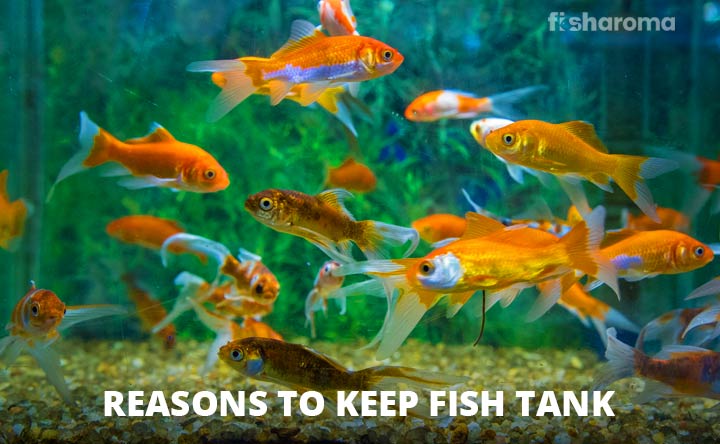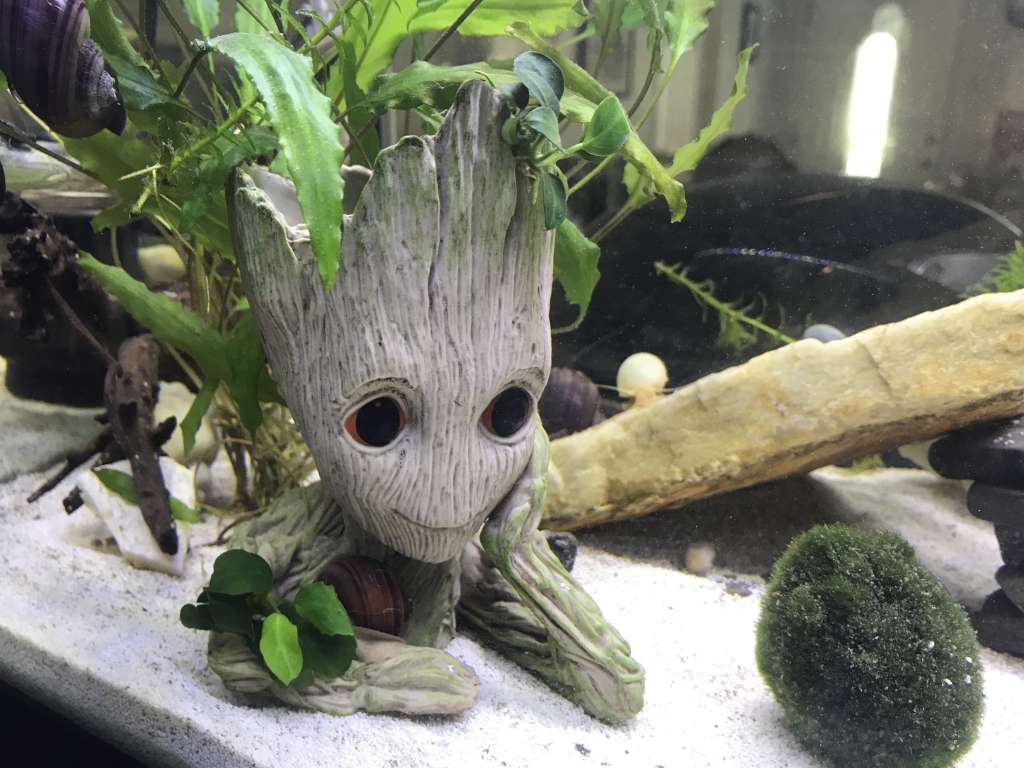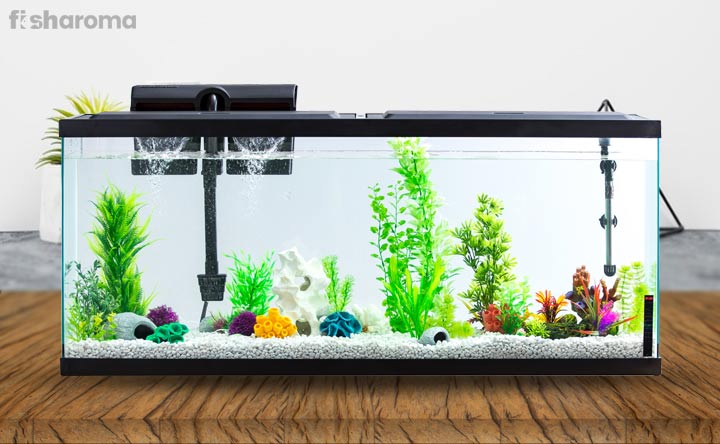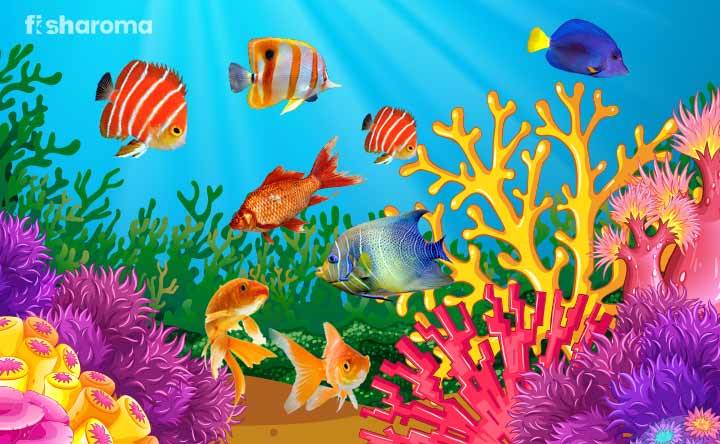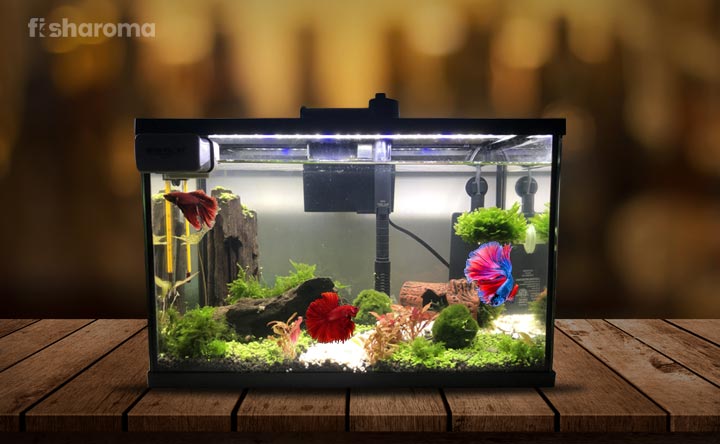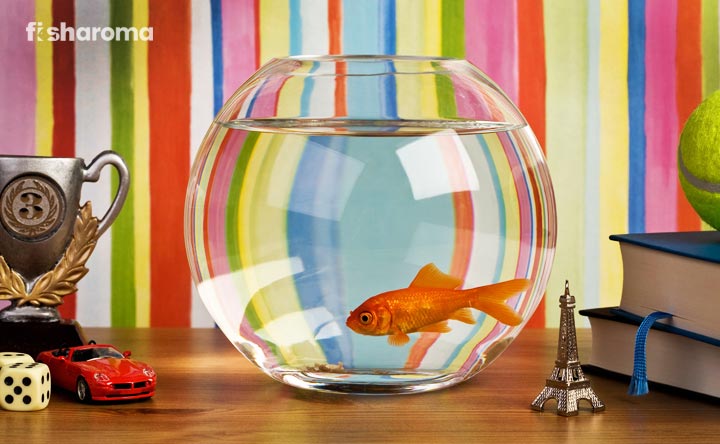How to Set-Up a Cichlid Tank?
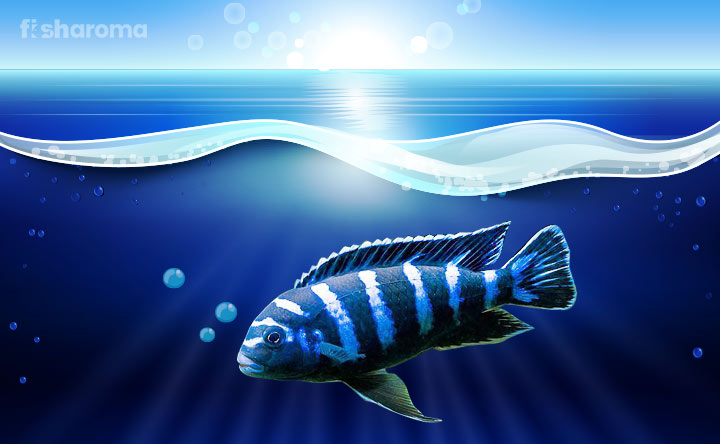
- Step 1 – Buying the Apt Tank
- Step 2 – Positioning the Tank
- Step 3 – Selecting the Right Substrate
- Step 4 – Provide the Right Type of Water
- Step 5 – Installing a Filtration System
- Step 6 – Decorating the Tank
- Step 7 – Cycling Your Tank
- Step 8 – Maintaining a Healthy Diet
- Step 9 – Choosing Compatible Tankmates
- Step 10 – Tank Maintenance
- Summary
Cichlids are an absolute favorite of freshwater aquarists because of their distinct colors and aggressive temperament. Among the various reasons people pet Cichlids, the one major reason is their active energy, since they explore every single inch of your aquarium. But despite being one of the most common aquarium pets, there is still a lack of knowledge among fish-keepers as to how to create a proper living environment for a Cichlid. So this is why we bring for you everything you need to know to build the perfect Cichlid tank.
But before we get into that, it is important to know a bit of their background because if we don’t understand where they came from and who they are, how can we provide a suitable living condition for them?
Getting to Know about Cichlids
Belonging to the Cichlidae family, Cichlids have more than 2,000 species, most of whom are found in Africa and South America. Some species of Cichlids, such as Tilapia, are an important source of food for us, while some other species, such as Peacock Bass, Mayan Cichlid, and Jaguar Guapote, are considered valued game fish.
Most other species of Cichlids are petted by hobbyists in freshwater aquariums. Prominent among them are Discus, Angelfish, Convict Cichlid, and Oscars.
Coming in a variety of colors, they are cylindrically shaped and have an elongated flat body. Their size can range from an inch long (in case of Multies) to 3 ft in length (in case of a Giant Cichlid).
Most species of Cichlid are herbivores by nature, although there are other species of Cichlids that feed on small invertebrates. They have a great visual appearance and often display complex, unique behavior that is riveting to watch in an aquarium.
Game fish refers to the fish that are fished for recreational or competitive purposes as part of a sport.
Setting Up a Cichlid Tank
Although Cichlids are counted among the most intelligent and advanced freshwater fish, they often get a bad reputation for being tough to handle, mainly due to their territorial nature. While this is somewhat true, it has been seen that they can healthily live if you carefully prepare and build a safe living space for them in a captive environment.
To do the same, we list out the steps you need to take to ensure that you have a perfect Cichlid tank ready before you buy them from your nearest pet store.
Step 1 – Buying the Apt Tank
The first thing that you need to do is to buy an appropriate tank for housing your Cichlid. The tank that you keep your Cichlid will be their habitat while they grow up. Now, a captive environment will never be the same as the natural habitat of these beings. But we always try to mimic as much similarity as possible between the two. There are three aspects of this step that you need to keep in mind:
Tank Size
The size of Cichlid can vary from very small to extremely large as we have stated above, but on an average, they grow between 5-6” (12.7-15.2 cm). So, considering their size, you can go for a 29-gallon tank.
However, a 50-gallon tank would be more appropriate since you don’t have to worry about shifting your Cichlid to a larger tank when they grow up to their adult form. It is also recommended to buy a horizontal tank than a vertical tank.
Tank Lid
This is a safety blanket for your Cichlid, especially if you have other pets, such as a dog or cat, or small children who might nip and harm these beautiful creatures.
A tank lid will also ensure that the water stays free of dust and outside pollution. Besides, a lid will also eliminate the chance of your pet jumping and leaping out of the water to their death.
Lighting System
One of the most striking features of Cichlids is their color. Naturally, when you are hosting them in your aquarium, you would want to highlight their color with a proper lighting system.
In the wild, Cichlids live in the dark water of the lower lake bottoms. If you want to go for this natural lighting, you won’t be able to highlight the bright colors of your Cichlid. However, if you want to go for the bright light system, there are ample choices for you. You can go for fluorescent lights, compact fluorescent, metal halides or LED lights, as you desire.
One thing that you need to make sure is that the lighting system is automated. Cichlids would need periods of darkness for their body to function normally. Having an automated lighting system will ensure that the lights stay on for 12 hours a day, and stay off for the rest of the day.
Step 2 – Positioning the Tank
Positioning the tank correctly is important because it ensures that the climate inside the tank and other internal factors are under your control. When you are keeping your fish in a captive environment, it is better to avoid as many variables as possible.
Try to avoid keeping it under direct sunlight because that may raise the temperature of the water to an unsuitable level. Besides, sunlight also enables the growth of algae, which you definitely want to avoid in your tank.
Furthermore, placing the tank near a power outlet will make sure that you don’t have to use lengthy cords to bring power to your tank. Having the water source nearby is also beneficial because that would mean that you don’t have to haul large buckets of water during replacement of the tank water.
As long as you are fulfilling these points, you have the complete discretion of where to display your Cichlid tank – in your bedroom, dining hall, living room or garden area.
Step 3 – Selecting the Right Substrate
Substrate refers to the base material that you put at the bottom of your tank. It plays a crucial part in the health of your fish apart from adding to the aesthetics of your aquarium.
There are different types and colors of substrate available in the market for you to choose from – sand, clay, pebbles, gravel, peat, soil, among others. There are also a number of artificial substrates available in the market, notable among them being CaribSea Eco, Seachem Flourite and ADA. Most of the Cichlids prefer sand-based substrate, although some species such as the Convicts prefer gravel-based substrate.
Having a substrate of contrasting tone also beautifies your fish by making them pop. This essentially means that when you have dark-colored Cichlid, they will be easier to spot on a light-colored substrate whereas when you have light colored fish, it is recommended that you should go for a dark substrate.
The color of the substrate can be anything as long as they are made up of non-toxic materials. Sometimes, substrates are dyed in toxic materials that can have a disastrous result when put in an aquarium.
Substrates also help in accelerating the cycling process of your brand new aquarium, which we would discuss later in the article.
When you buy a substrate from the market, make sure you wash it thoroughly before putting them into the tank, even when the package says that the substrate comes pre-washed. It is often seen that substrates come with dirt, which tends to make the tank water murky and cloudy.
To clean the substrate, just run them under running water or in case of gravel or pebble-based substrate, use a hosepipe. Do not use soap to wash them since the residue of soaps in the substrate will be harmful to the fish.
Amount of Substrate
You should have at least 3” of substrate layer for your Cichlid tank. For having 3” of the substrate, you would need 3 lb. of substrate per gallon of water. The following table demonstrates the amount of substrate needed based on tank size for creating 3” of the substrate.
| Tank Size (in gallons) | Amount of Substrate Needed (in lbs.) |
| 29 | 87 |
| 50 | 150 |
| 75 | 225 |
| 90 | 270 |
| 100 | 300 |
| 125 | 375 |
| 150 | 450 |
Step 4 – Provide the Right Type of Water
With the substrate set, you now have to focus on the type of water that Cichlids need to survive. When you pour the water onto your tank, try to place a saucer or bowl inside the tank and gently pour the water over it so that the substrate inside the tank doesn’t get disrupted by the flow of the water.
The water for a Cichlid tank has to meet the following criteria:
Temperature
The optimum temperature of the water inside a Cichlid tank has to around 72-82° F (22-28° C). To maintain this temperature, you have to use a water heater. Also, use a submersible thermometer that will help you keep a tab on the temperature of the water.
pH Level
Ideally, the pH level of the water should be 7.8-85. Any deviation in the pH level can be fixed by keeping limestone rocks and crushed coral substrate in the tank. Try to keep a pH testing kit in your home to test the water on a weekly basis.
Low pH means your water is acidic while a higher pH level means your water is alkaline.
You can also use buffers in your tank to lower and raise the level of pH. To lower the pH level of the tank water, you can use Seachem Acid Buffer, whereas if you want to raise the pH level of your water then you can use Seachem Alkaline Buffer. In both cases, you need to keep on adding one teaspoon (2 gm) of the buffer to every 20 gallons of water until you reach the desired pH level.
Mineral Level
The mineral level of your water should also be checked for ensuring the good health of your fish. Cichlids are extremely sensitive towards ammonia spikes (NH3). Its level should be 0 ppm (parts per million). High ammonia level weakens the fish and makes them breathe rapidly.
Next, you need to check the level of nitrite and nitrate, too much of which is also lethal for your fish. The level of nitrite should also be 0 ppm while the level of nitrate should be less than 40 ppm. Replacement of water is the best way to keep the level of nitrates under control. We will discuss the replacement procedure in length later in this article.
Hardness
The relative hardness of the water should be between 10-15 dKH. This level of hardness reflects the natural habitat of Cichlids where the hardness is caused by limestone rocks. You can use small limestones or limestone powder to achieve the optimal hardness level.
Apart from these four points, it goes without saying that the water which you are going to use should be crystal clear, both for health-related reasons and for aesthetic value. After securing the right quality of the water, you would have to install a filtration system in your tank.
Step 5 – Installing a Filtration System
Filtration is required for keeping the water in your tank clean and healthy. What an aquarium filter does is that it draws water from the tank and runs it through its media. In this process, all the waste products, debris, and unwanted chemicals get pulled from the water, and the cleansed water is released back into the tank.
Depending on the type of filter media, it is determined how much waste is cleansed from the water. An aquarium is cleaned using biological, mechanical or chemical materials.
Biological Filter
This filtration system allows for beneficial bacteria to grow and develop. The bacteria filters the water column by a process known as Nitrogen Cycle. Since Cichlids produce a lot of waste, it is important to manage the amount of ammonia released in the tank through these wastes. Biological filtration is a must for a Cichlid tank.
Mechanical Filter
A mechanical filter pulls waste materials and debris from the water. In a captive environment, Cichlids have been seen suspending debris in the water column. As a result, in addition to a biological filter, you would also need a mechanical filter. There are many filters in the market that combine the purposes of a biological and a mechanical filter, although you can also install a mechanical filtration system separately through a secondary filter.
Chemical Filter
This filter media is made up of activated carbon that removes impurities from the water, making it non-toxic. However, they are infamous for changing the pH level of the tank water. Therefore, this media is the least preferred of the three.
Based on the filtration media, the best filters for a Cichlid tank are a Hang-On-Back (HOB) filter since they provide both biological and mechanical filtration along with supplying additional aeration. You can also opt for a canister filter since they clean huge volumes of water every hour. They also provide all three filtration types. Sponge filers with power-heads provide biological and mechanical filtration as well. Try and avoid under-the-gravel filters since most Cichlids use sand as a substrate.
The key things to consider while buying a filter for your Cichlid tank should be its flow-rate (which should be 2-4 times the tank’s volume), ease of accessibility and the volume of media held.
Step 6 – Decorating the Tank
The next plan of action is to decorate your Cichlid tank. Now, as much as plants are important in a fish tank since they help in controlling the nitrate level, sadly you won’t be able to host most plants in a Cichlid tank. This is because the high pH level is not suited for the survival of most aquarium plants. Besides, Cichlids often eat or uproot plants, thereby jeopardising your efforts. Very few plants, such as java moss or Amazon Sword plant, can co-exist with a Cichlid.
But don’t be too sad, since there are still a bunch of items that you can use to decorate your aquarium. Pick up some aquatic caves and rocks since they will serve as hiding spots for your fish. Cichlids also love to excavate and move rocks around, so don’t stress yourself about arranging and re-arranging the rocks. Just place the larger rocks at the back and the smaller rocks in the front since that will create a sense of depth.
Try to use small white limestone rocks as they will help maintain proper pH level. You can also use small clay pots and coral pieces. Do not use driftwood as that would change the pH level and hardness of the water.
Step 7 – Cycling Your Tank
This step essentially involves adding beneficial bacteria to your tank before introducing the fish. In this process, ammonia is added continuously, which gets turned to nitrogen and nitrate in the presence of these bacteria. It usually takes 4-6 weeks for the tank to become healthy enough for the fish.
To do an aquarium cycling, you need to fill up your tank with everything apart from the fish. After that, keep on adding fish food and household ammonia (janitorial ammonia) to the water. Buy an ammonia and nitrate test-kit and make sure that the level of ammonia stays at 2 ppm for the first 2-3 weeks. After that, bring down the level of both ammonia and nitrate to 0 ppm. After another week, replace 50% of the water with tap water. Two days, replace 50% of the water with tap water again. Your tank would then be ready to host your fish.
Step 8 – Maintaining a Healthy Diet
You can ensure that your fish live up to their full lifespan by providing them with a healthy diet. First of all, try to find out whether the species of Cichlid that you have in your tank is a herbivore or an omnivore. Depending on it, a proper diet of a Cichlid should consist of:
- Bloodworms
- Brine Shrimp
- Crayfish
- Fruits such as melons, bananas, and peach
- Green vegetables such as asparagus, spinach, and lettuce
- Bloodworm
- Daphnia
You can feed both live and frozen food to your Cichlid. However, in the case of frozen food, make sure you thaw it properly before feeding it to them.
Step 9 – Choosing Compatible Tankmates
As we have stated above, there are many species of Cichlids, the main among them being the South American and African species. It is recommended to keep Cichlids of only one species together. There are also various breeds within each species, which are generally safe to keep together.
If you plan to keep more than one Cichlid in your tank, make sure they are of the same size, otherwise, the larger ones will bully the smaller ones. Also, it is better to keep two female Cichlids for each male Cichlid. This will help control the aggression of the male Cichlid.
Most fish can’t co-exist with Cichlid because of their territorial, aggressive nature. A bottom feeder such as an Apple Snail or Plecostomus, however, is a good fit for a Cichlid.
It has been seen that Cichlids can co-exist with other peaceful fish that are larger than them.
Step 10 – Tank Maintenance
Last but not least, maintenance of your tank is crucial for the longevity of your fish. It involves everything from water replacement to cleaning of ornaments and tank walls. A Cichlid tank gets dirtier often than an average tank due to the large production of organic wastes. Therefore, cleaning becomes all the more important here.
Water Replacement
Never replace all of the water at once. It will throw off the ecological balance of the tank. Your Cichlids will go into a shock that may result in their death.
Ideally, you should replace the water on a periodic basis so that both you and your fish get habituated with the process. If you want to do it on a weekly basis, then you need to replace 5% of the tank’s water. Else, you can replace 15% of the tank’s water every 15 days. On a monthly basis, you should replace 30% of the tank’s water. The water that you add in must have all the properties of the existing water in the tank.
Cleaning Method
Do not use soap, detergents or any other harsh materials to clean the ornaments of your aquarium. This is because the chemicals from soap are harmful to a fish even when they are thoroughly washed beforehand. Just use simple lukewarm water to clean your products. Use a soft cloth to wipe off the algae and waste residue from the interiors of your tank wall. Using a siphon to replace water also ensures the removal of waste materials and debris from the substrate of your tank.
Try to maintain regularity to your cleaning method and water replacement. It will make sure that the environment your fish is growing in is healthy.
Cichlids are a fascinating creature and it is no wonder why they are a favorite of so many aquarists. From their colorful body to their amusing behavior, they will keep you charmed round the clock. However, the difficulty in their care-level cannot be denied, since they produce a lot of wastes. So, if you are ready to put heavy effort, then this is the fish for you. With our guidance, we hope now you have a better understanding of how you can create the perfect Cichlid tank.
Interesting Facts about Cichlids
- Cichlids sleep with their eyes open since they don’t have eyelids.
- They communicate with each other visually, acoustically and tactilely.
- Lake Malawi, located in Mozambique, is home to over 1,000 species of Cichlid.
- The International Union for Conservation of Nature (IUCN) has declared 156 species of Cichlid as vulnerable, 40 species as endangered and six species as extinct.
Summary
Cichlids are a fascinating creature and it is no wonder why they are a favorite of so many aquarists. From their colorful body to their amusing behavior, they will keep you charmed round the clock. However, the difficulty in their care-level cannot be denied, since they produce a lot of wastes. So, if you are ready to put heavy effort, then this is the fish for you. With our guidance, we hope now you have a better understanding of how you can create the perfect Cichlid tank.
Similar Fish-Keeping Guides
If your interests extend beyond just building a tank for Cichlids, take a look at our other fish-keeping guides.
- Pipefish – Want to pet an unconventional fish? Pipefish is the one that you are looking for then. Learn how to pet it here.
- Crowntail Betta – Nothing beats the beauty of a Crowntail Betta, which is considered to be an aquarist’s delight. Take a look at how to host them in your home.
- Emperor Angelfish – A saltwater beauty, the Emperor Angelfish can be quite difficult to raise, but not that difficult if you learn how to raise them with us.


